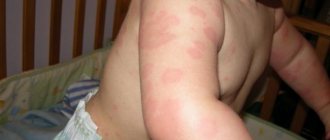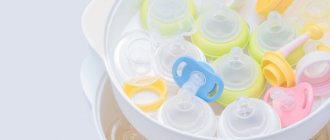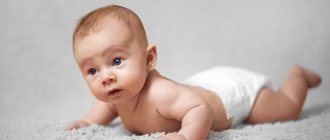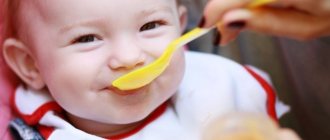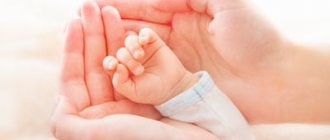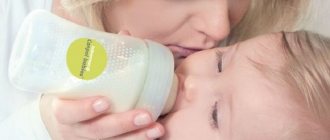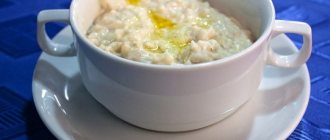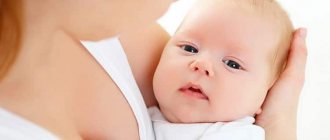HOW MANY BOTTLES DO YOU NEED?
You can pour not only water or baby formula into feeding bottles, but also juice, porridge or grated soup. In this regard, parents have a logical question: how many bottles should they have on hand and what kind?
There is no universal answer, since everything depends on the type of feeding the baby, the mode and conditions of feeding, as well as the age of the baby.
Experienced mothers and experts believe that:
- with regular breastfeeding, only one small bottle (100–150 ml) of water may be needed on demand;
- with regular breastfeeding according to the regimen, you should stock up on one small and one large (250–330 ml) bottles - for water and expressed milk;
- with mixed and especially artificial feeding, you will need at least 4-6 bottles (for milk/formula and water).
For example, at night the child may ask to eat several times. In order not to make the baby wait for a long time (while you prepare a new portion of the mixture), it is better to prepare food for future use and, if necessary, quickly reheat it.
Advantages of plastic bottles:
- lightness of the material (in the future the child will be able to hold the bottle himself);
- safety (do not break);
- larger assortment (most modern bottles are made of plastic).
The main requirement for plastic feeding bottles is that the plastic contains no harmful substance – bisphenol-A (BPA). DINO&RHINO plastic bottles meet this requirement.
The advantage of glass bottles is durability: glass is less susceptible to scratches, does not wear out and does not turn yellow over time. Plastic bottles still need to be replaced periodically.
Bottle volume
It’s simple here - the volume depends on the age of the baby and the amount of milk (formula) consumed per meal.
There are three popular bottle sizes: 125 ml (up to 3 months), 260 ml (up to 6 months) and 330 ml (from 6 months).
How many bottles should you have in stock?
At least one of each size, but we recommend purchasing at least a pair if you plan to bottle-feed your baby frequently.
You will have to feed your baby approximately every three hours. Between feedings, you will have a lot to do, and also an urgent need to rest. Usually, during the first few months, bottles are not only washed, but also sterilized. Washing and sterilizing one bottle after each feeding is not convenient for everyone.
What types of bottle nipples are there?
Material: latex and silicone nipples
Both latex and silicone nipples are suitable for feeding babies from birth. Latex nipples are softer, but less wear-resistant and more difficult to clean from contamination. Latex can also cause allergies in babies.
WHAT SIZES ARE THE BOTTLES FOR NEWBORNS?
An important factor on which the choice of baby bottle depends is its volume. Manufacturers offer dishes of different sizes and shapes, taking into account the age of the child and his “menu”. Since in the first months of his life a baby can drink up to 90 ml of milk at a time, a 100-200 ml bottle will be enough for him. Grown-up toddlers require larger dishes - up to 330 ml.
For ease of use, a measuring scale is applied to the surface of the bottle, allowing you to pour the optimal amount of milk, as well as ensure precise proportions for diluting milk mixtures. The scale can be drawn, convex or embossed (the second and third options are preferable, since drawn markers fade and wear off over time).
MATERIALS
Previously, only glass bottles were used to feed newborns. Nowadays they also use utensils made of plastic and silicone. Each option has its own advantages and disadvantages that should be considered before purchasing:
| Material | Peculiarities |
| Glass | In the manufacture of bottles, durable fire-resistant glass is used. Such dishes can serve for many years. It is not afraid of sterilization, is hygienic and environmentally friendly, and does not stain under the influence of various products. Glassware is easy to clean. Among the disadvantages, the fragility of glass and heavy weight should be noted. |
| Plastic | These bottles are easy to use. They are lightweight (compared to glass counterparts). High-quality plastic can withstand high temperatures (boiling water can be used). Dishes of different shapes are made from plastic. The disadvantages of plastic include the fact that over time, microcracks may appear on the bottle, and the surface of the bottle may also become stained (for example, if juice is poured into it). Also, low-quality plastic bottles may contain the dangerous substance bisphenol A - so their composition must be checked before purchasing. |
| Silicone | Silicone cookware is easy to use. It is light in weight, does not break (withstands mechanical stress), and is hypoallergenic. The peculiarity of silicone bottles is that they are soft and can be squeezed, which has its pros and cons. For example, milk may spill if squeezed too hard, but it is more convenient to eat porridge from such a container. |
If you prefer glass containers, do not give them to your baby as the bottle may be too heavy for your baby and he will drop it. For independent toddlers, polymer and silicone analogues are more suitable, they are very convenient for a walk or on the road.
Feeding bottles - how much to buy
For artificial drinkers, the mandatory minimum will be the purchase of at least six bottles of different sizes.
These are containers with nipples for 250 ml formulas; 100 or 150 ml bottles are suitable for water. At least four different bottles will be needed during artificial feeding per day, so that family members have time to sterilize dishes and prepare nutritional mixture for the baby. Breastfeeding does not eliminate the need for bottles. The baby will need to buy one or two small bottles of 100-120 ml for water; larger bottles can be taken on the road. They will also be needed when introducing complementary foods, but for breastfed newborns there is no need for large bottles. You can give water or dill water to your baby using a spoon.
When choosing a bottle, you should give preference to containers that are easy to use and safe. Therefore, it is better to purchase sets from well-known manufacturers, equipped with quality certificates. Such products are made from environmentally friendly materials.
HOW TO DETERMINE QUALITY?
If you ask your pediatrician to recommend a bottle for a newborn, he will definitely pay attention to the quality of the materials. So, when choosing plastic utensils, make sure that they do not contain phthalates and the substance bisphenol A. This is a chemical that gives polymers increased strength and transparency, but when heated, bisphenol can accumulate in the body. This toxin is dangerous due to its effects on the human endocrine, reproductive and immune systems; in addition, it can cause cancer. Since 2010, plastics containing bisphenol A have been banned in many countries.
The weight and hardness of the bottle will help you draw a conclusion about the quality of the polymer. If it is designed to hold 250 ml, it must weigh at least 25 g and cannot be pressed down. Otherwise, we can talk about low quality of the product (the wall thickness of such bottles is uneven).
LET'S TALK ABOUT FORMS
What is the best bottle shape to choose – inexperienced mothers often ask pharmacists and on various parenting online forums. The entire range of bottles available today can be classified into the following main types:
- Classic bottles in the shape of a straight cylinder. They are quite easy to use and care for, but it is not very convenient for the baby to hold them in his hands - they are too wide.
- Figured variations. Many manufacturers offer their own design solutions. These can be models with a recess in the middle, concave in the middle or at the top, widened at the bottom, etc. “Convexity” and “concavity” are designed to make gripping the bottle as comfortable as possible, but this makes the process of caring for the dishes more complicated.
- Wide-neck models designed for preparing mixtures directly in the bottle.
- Curved models with the so-called anti-colic system. These bottles are equipped with a gas outlet tube, which allows you to cope with the problem of the baby swallowing air while eating.
Classic bottles, which are made of plastic and glass, are universal - they can be used for milk, mixtures, cereals, and juices. Dishes of non-standard shape and bottles with wide necks are usually made of plastic (some models additionally have a sealing disk, which ensures the tightness of the container).
Before giving preference to any option, experts advise assessing its practicality and convenience. For example, for the smallest babies there is no point in buying a figure model - the baby will still not be able to hold it on his own. It is also worth remembering that such a bottle will not be easy to wash, so it is better to use it only for water or juice. Well, if your child has digestive problems, try the anti-colic option.
CHOOSING A BOTTLE NEAT
The quality of a child’s feeding also depends on the pacifier - you need to approach its choice with the same scrupulousness as when buying a bottle. Nipples differ in material, size and shape. For example, a silicone baby bottle nipple is denser and more durable than a latex one, but is easier to bite through.
- When choosing, it is recommended to take into account the following nuance: babies themselves usually prefer soft latex nipples, which, when heated, feel like human skin. But mothers who practice mixed feeding should give preference to silicone analogs, because after trying soft latex, the baby may refuse to breastfeed, since it is much easier for him to “get” milk through the nipple.
As for the shape of the nipples, they can be completely round with a simple oblong base or have a beveled edge. The first option is ordinary standard nipples, the second is anatomical models created taking into account the physiological characteristics of the oral cavity of infants. Samples with a wide base are also on sale - such an accessory, according to the developers, most closely resembles a mother’s breast. The baby himself must choose the appropriate option - often parents have to experiment with different nipples until the child is satisfied with a particular model.
The sizes of the nipples are also unequal (the larger/older the baby, the larger the accessory he needs). Typically, pacifier packages contain numbers from 1 to 4: for the first month, second, third to sixth months, and No. 4 for babies from six months. However, different manufacturers may have their own grading, so before purchasing, do not be lazy to read the instructions.
But that's not all! To make it as comfortable as possible for the baby to drink milk, the mother should choose a pacifier with the optimal flow rate. What is meant? The baby must receive food under a certain pressure: if it is too small, the child will not get enough to eat, and if it is too big, he will choke. The pressure is regulated thanks to the holes in the nipple, and the intensity of the flow depends on their type and quantity.
- If the bottle has to be used from the first days of the child's life, size zero is suitable.
- For babies from 3 to 6 months, use nipple No. 1 with a slow flow and nipple No. 2 with a medium flow (for milk). Pacifier No. 2 is also useful for drinking juice and tea for babies from 6 to 12 months.
- Fast flow nipples (No. 3) are intended for children from 1 year of age.
- The fourth number with a cross-section is convenient for consuming not only milk, but also thicker foods, such as porridge. This pacifier is suitable for a six-month-old child.
- From three months onwards, you can use nipples with variable flow (the flow intensity can be adjusted if necessary).
Above we mentioned the anti-colic system in bottles. The nipples themselves can also be anti-colic - these are models with special holes and/or a channel (valve).
Advantages of silicone nipples:
- hypoallergenic;
- wear resistance;
- material strength;
- lack of taste and smell;
- hygiene (better to wash).
It is important that the product packaging also bears the marking that it does not contain bisphenol-A. DINO&RHINO bottle nipples are made of BPA-free silicone.
Nipple flow rate
The flow rate of the nipple is the volume of liquid that is released “in one sip”; it depends on the age of the baby.
Different speeds are usually indicated on the packaging by droplets (one, two, three), numbers (1, 2, 3) or age markings (0+, 3+, etc.).
It must be remembered that the numbers on the nipple (or the number of droplets) are not identical to the age of the child. Carefully study the product packaging (age group must be indicated).
There are three main flow rates: slow (0-3 months), medium (3-6 months), fast (from 6 months). There are also nipples with variable flow and separate ones for porridge.
The nipples that come with bottles of different sizes, as a rule, already correspond in flow rate to the desired age group. But sometimes the nipple needs to be replaced due to wear and tear (there is no need to buy a new bottle for this), or the bottle is too comfortable, and the baby has grown, or you are planning to start feeding your baby porridge from a milk bottle. You can always purchase any DINO&RHINO bottle nipple separately.
ADDITIONAL ACCESSORIES
To satisfy all the wishes of customers, manufacturers are trying to constantly improve feeding bottles and also create additional accessories for them. Thus, the set with the bottle may include an additional lid that simplifies the process of storing food, a brush for washing the container, and an airtight plug.
In addition (and sometimes instead) of a bottle, mothers use a device called a sippy cup. This is a special sealed cup with a spout. When answering the question of how to choose a sippy cup for a child, pediatricians advise paying attention to the material (it should be durable, non-toxic plastic), volume (the cup should “grow” with the baby) and a design that is easy to use and care for.
Assortment of feeding bottles
Bottles are made of glass or plastic. Glass bottles are designed for the smallest children; they are environmentally friendly, easy to clean and sterilize. But lately they have been used less and less, giving way to their plastic counterparts. Such bottles are lighter in weight, do not break and are amenable to a large number of sterilizations. There are also silicone bottles that imitate mother's breasts.
The bottles also differ in shape. These can be standard cylindrical bottles that are very easy to keep clean. Bottles with removable handles, tapered or donut-shaped will come in handy at the moment when the child learns to hold the bottle on his own. Round bottles, reminiscent of a mother's breast, are suitable for the most demanding babies. Special inclined anti-colic bottles prevent air from being swallowed during feeding. On the Internet you can find exact information on how many bottles a newborn needs, and which manufacturers are better.
The volume of bottles can be from 125 ml for the smallest and up to 300 ml for older babies. It makes the most sense to buy several bottles of different sizes. It is worth remembering that the child grows very quickly, so you should not buy more than two bottles of the smallest size.
All bottles are usually sold complete with nipples made of silicone or latex, which have holes of various sizes. Nipples vary in degree of hardness and can also be round, resembling a mother's nipple, or flattened for proper bite.
HOW TO CARE FOR FEEDING BOTTLES?
Now that you know how to choose the right bottle for your baby, it remains to remind you about the rules for caring for it.
- A new bottle must be sterilized before its first use (the instructions describe in detail how and how long to sterilize the product). In the future, the dishes should be regularly treated with boiling water. To thoroughly wash the container, use a brush.
- Since newborn babies are susceptible to various types of infections, it is recommended to sterilize feeding bottles. There are several methods of sterilization: the simplest is to boil the bottle according to “grandmother’s method” in a saucepan for 5–10 minutes. But this method is only suitable for glass containers; the plastic is deformed. Bottles can also be sterilized in a microwave and household electric sterilizers.
- Check your bottle and pacifier regularly. If you notice damage, cracks, discoloration, or plaque, it’s time to buy new cookware. There is no exact answer on how often to change a bottle, since it depends on the material (for example, glass models have an unlimited shelf life), the age of the child (the baby has grown up - he needs a larger bottle and, possibly, a different shape), the condition of the dishes (if plaque has formed, it is better to replace the container). Find detailed information in the instructions.
- Warming a baby bottle requires special attention. For this, many people use a microwave, but to simplify the process, special heaters (including car heaters) have been created. You can read the instructions for the bottle on how best to heat up food for your baby.
- The bottles come with caps - cover the nipple with them whenever you are going for a walk (or on the road), as well as at home if the bottle has been sitting idle for a long time.
How often should you change feeding bottles?
The frequency of replacing the container depends on the degree of wear. If you have a glass bottle and there are no cracks, chips or other defects on it, then you do not need to change it. The same applies to plastic products. Only the presence of swelling, cracks, dents, an unpleasant odor that does not disappear after sterilization, as well as color changes should force you to purchase a new container.
If the bottle is a one-time feeding bottle, then this container must be replaced after each feeding. Silicone containers also need to be replaced if the material changes color or develops an unpleasant odor.
A feeding bottle is an important item for a newborn. Even if a child feeds on mother’s milk, he periodically needs to drink water, and over time the baby will need to be fed, so you can’t do without a special container.
Your task is to choose a high-quality and safe product for your newborn. Today, the children's goods market offers a huge number of bottles for newborns and children of the first year of life. There are a lot of manufacturers, among the most famous and well-established ones are Philips Avent, Dr.Brown's, Medela, Pigeon, Chicco, Munchkin, Nuk and some others.
There are a lot of nuances when choosing a bottle, but one of the most important criteria that needs to be taken into account when choosing a bottle is the presence of a physiological nipple.


